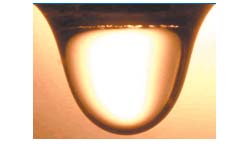| 2005 |

|
YEAR BOOK |
Institute of Technology Carlow
|
The shape of a drop
|

Drop Modelling
Two different approaches were adopted to model drop profiles using 1) the Bashforth and Adams equations and the Runge-Kutta procedures for solution and 2) the Fordham & Mills equations. All models were compared to a real digital camera image of a water drop formed on a 9mm orifice (see figure).
These studies have shown that the standard methods for drop shape modelling do not provide adequate fits for pendant drop shapes except by using such artifices as non-linear error computer approximations. Existing expressions for such drop shapes are based on numerical solutions to the Laplace-Young equation, which unfortunately are unable to describe the actual drop shapes that are measured.
The intention of the research is to obtain accurate fits to equilibrium or quasi-equilibrium drop shapes for tensiography. A simple yet accurate analytical expression is currently being investigated that describes the shape of pendant liquid drops supported on a large drophead. The expression is being tested experimentally over a range of drops for a class of drops that has considerable practical importance.
Vibration Studies
A great deal of work has been done at this stage, initially developing some new experimental insights into surface rheological properties while seeking to design drop hardware that would enable small volume measurements of viscosity to be made. Insights into surface rheometry have been obtained using optical monitoring of vibrating drops and using these methods to characterise the mechanical properties of liquids.
A Fourier analysis of the optoelectronic signal obtained from internal reflections of light inside a drop, which has been mechanically excited, has been undertaken. A study using a range of liquids has revealed the existence of the drop vibration modes on pendant drops. The relationships of the various frequency components to the properties of the test liquids have been investigated. Studies have been undertaken into the consistency of these effects to determine whether there exists a quantitative instrumental basis for exploiting this knowledge to yield physical properties of small volumes of liquids.
Contact: Des Carbery,
Department of Mechanical and Civil Engineering;
Institute of Technology Carlow, Kilkenny Road, Carlow;
E-mail: [email protected]